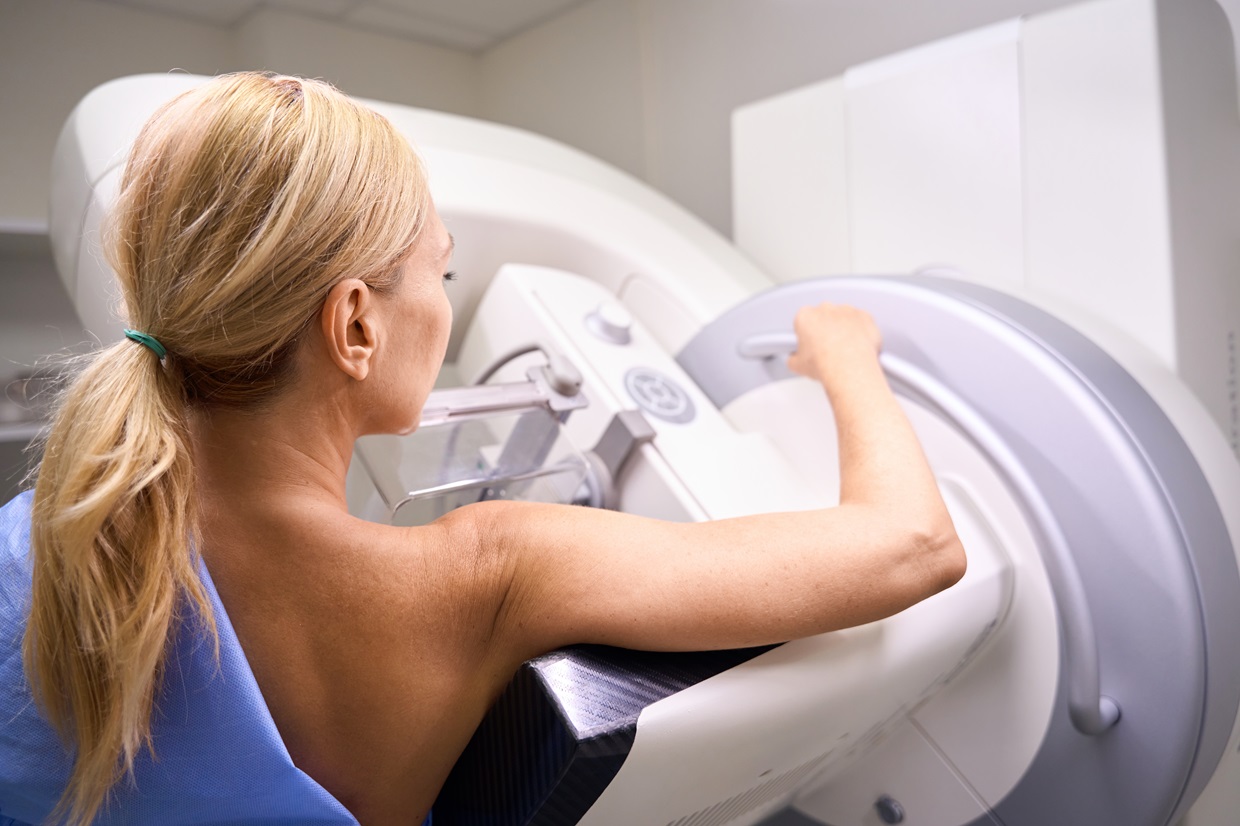Table of Contents
The probability of positive outcomes significantly increases if breast cancer is detected early through regular mammography and self-examination at home, well before the disease can affect the body. Breast cancer screening is an essential tool in the fight against breast cancer: it allows for early diagnosis and saves lives.
There is no benefit in merely ensuring regular check-ups for breast cancer, which is the leading cause of cancer-related deaths among women. That’s why balancing life and detection is crucial—not only for treating cancers like breast cancer but also for ensuring that detection occurs much earlier than the treatment stage.
What is Breast Awareness?
It is important to develop the habit of self-examination, checking for lumps, pain, or unusual discharge by visually inspecting the breasts. Breast awareness means recognizing changes or concerns, noting how the shape and size of your breasts may change (e.g., due to pregnancy), and being aware of any skin or texture differences. Early warning signs include redness or swelling.
Visiting a Family Doctor
Maintaining good health requires regular visits to the doctor, who can detect health problems early and provide preventive advice. If you experience any signs or symptoms, consult your doctor, who can refer you to specialists if necessary. Regular check-ups are important to identify health issues as early as possible. Your doctor is responsible for managing chronic conditions such as diabetes and hypertension, monitoring your progress, and possibly adjusting medications or suggesting changes in your care. Building a professional relationship with your primary care physician ensures better communication and optimal individualized care. If you have any questions or concerns about your health, do not hesitate to contact your primary care doctor.
When and How to Examine Your Breasts
Regular breast or chest examinations are crucial for early diagnosis. Perform a self-examination after your monthly cycle, or if you do not have periods, choose a consistent day each month. Familiarizing yourself with how your breasts normally look and feel can help you detect any changes in the future.
Another method is to perform a self-exam while standing in front of a mirror with your shoulders straight and arms naturally raised. Note any changes in appearance. Raise your arms and look for any changes. Finally, while standing or lying down, feel your breasts with a firm touch using the pads of your three middle fingers.
What to Look For
When conducting a breast examination, look for lumps or thickening in the breast or armpit. Pay attention to changes in the size or shape of the breast, dimpling, or skin pulling. Nipple changes, such as inversion or unusual discharge, and localized skin changes around or beneath the nipple should also be monitored. If you experience breast pain, consult a doctor immediately. Recognizing these signs and performing regular self-exams can increase the chances of successful treatment, potentially leading to early detection and a better outcome.
Breast Pain
At some point, many women experience breast discomfort, known as mastalgia. It can affect both breasts or just one. Breast pain is rarely a symptom of cancer and is often related to hormonal changes, such as those occurring during menopause, pregnancy, or menstruation. Non-cyclical breast pain can also be associated with musculoskeletal issues, medications, or injury. Be aware of any new breast tenderness that persists or worsens over time, as it might indicate another issue. Consult a healthcare professional to determine the cause and explore treatment options.
Detecting Breast Cancer Through Screening
Early-stage cancer can only be detected through clinical breast exams and mammograms. Clinical assessments, which involve palpation by a doctor and mammograms, use X-rays to look at breast tissue for changes that might indicate cancer. These screenings help detect cancer early, significantly improving treatment outcomes. Mammograms are typically recommended for women aged 40 and older and for those with a family history of breast cancer. Regular annual breast exams by healthcare professionals are essential to improving early detection chances. Women should meet with their healthcare providers to plan screenings based on personal risk factors.
Benefits of Early Cancer Detection
The most obvious benefit of early cancer detection is increased survival rates. Early detection leads to better outcomes and higher chances of recovery due to more effective treatments. Moreover, early detection can reduce the need for aggressive treatments that may negatively impact a patient’s health. Additionally, treatments for early-stage cancer are often less costly, easing the financial burden. Early detection allows individuals to enjoy life more, without the emotional toll of late-stage cancer symptoms. This also helps the families or caregivers of patients feel more assured of their loved one’s progress.
Breast Awareness
Knowing your breasts means understanding how they look and feel. Self-examination can help identify any potential issues, such as lumps, skin changes (which could indicate breast cancer), or nipple discharge. It is crucial to understand the importance of this type of examination, along with mammography and clinical breast evaluation. Early breast cancer diagnosis is essential to increasing the chances of survival by seeking medical attention before symptoms appear. Knowing how to examine your breasts builds confidence and keeps you proactive in your health. It’s also important to lead a healthy lifestyle, considering various factors such as age, genetics, and lifestyle choices. Be informed about breast health: Learn and use tools for self-examination and know when to start screening for breast cancer. Take charge of your health and well-being by being aware. Do not leave any health concerns unresolved.
If You Notice Changes in Your Breasts or Chest
If you notice any changes in your breasts or chest area, it is important to contact your doctor immediately. They will examine any lumps, pain, swelling, or skin texture changes you’ve observed. Share any concerns with your doctor, who may perform a breast exam and recommend additional tests like mammograms or ultrasounds. Remember, early detection is the best protection. Research saves lives!
Breast Screening
Recognizing malignant breast growth in its early stages is crucial, making breast screening an important part of your healthcare routine. Typically, a mammogram (a low-dose breast X-ray) is performed to detect abnormal areas, including lumps or calcifications, that may indicate cancer. Screening is recommended for women aged 40 and older, although recommendations may vary based on risk factors and medical history. Regular screenings are crucial to detecting changes early, which can significantly improve treatment success. Healthcare experts encourage women to perform breast exams and undergo mammograms as recommended. Identifying any issues during these screenings increases the available treatment options. Make breast screening a regular part of your healthcare routine.
What is Breast Cancer?
Breast cancer occurs when breast cells grow uncontrollably, forming a tumor that can spread to other parts of the body. While it is more common in women, it can also occur in men, though rarely. Breast cancer is often treatable if detected early. Types of breast cancer include ductal carcinoma in situ (DCIS), invasive ductal carcinoma (IDC), and invasive lobular carcinoma (ILC). Each type grows and spreads differently, affecting treatment and outcomes. Breast cancer risk increases with age, family history, genetic mutations, and other factors. Treatment varies based on the type of cancer and may involve surgery, chemotherapy, radiation therapy, or targeted therapies.
Breast Cancer Symptoms
Symptoms of breast cancer may include lumps or thickening in the breast or armpit, changes in the skin such as redness or dimpling, or unusual nipple discharge. While not every lump indicates breast cancer, any noticeable changes should be evaluated by a healthcare provider. Early detection of breast cancer through self-exams, mammograms, and clinical breast exams allows for timely treatment and can significantly improve outcomes.
Breast Cancer Diagnosis
Diagnosis usually begins with a mammogram or physical examination for lumps or other abnormalities. Additional tests, such as biopsies, confirm the presence of cancer cells, leading to a definitive diagnosis. After diagnosis, additional scans determine the extent of the cancer’s spread. These tests help healthcare providers decide on the best treatment strategy, which may include surgery, chemotherapy, radiation therapy, or combinations of treatments. Support from specialists, family, and friends can be crucial during this challenging time.
Breast Cancer Treatment
Treatment options for breast cancer depend on the stage and type of cancer. Surgery often involves removing the tumor and some surrounding tissue. Post-surgery, radiation therapy targets any remaining cancer cells to reduce the risk of recurrence. Chemotherapy may be used to target cancer cells throughout the body or specific organs. Hormone therapy can be effective if the cancer is hormone receptor-positive, while immunotherapy boosts the body’s ability to fight cancer cells. Ongoing care involves regular follow-ups with a team of oncologists, surgeons, and other healthcare professionals to ensure appropriate treatment and care.
About Breast Cancer
Breast cancer is characterized by malignant cells that form in the tissues of the breast. While it can affect both men and women, it is more common in women. The cancer originates in the ducts or lobules of the breast, where early cell growth forms a lump that can be detected by mammogram or physical examination. Early detection of breast cancer increases the chances of successful treatment. Common symptoms include lumps in the breast, changes in shape or size, nipple discharge, and abnormal skin changes. Regular self-examinations, mammograms, and clinical breast exams are essential tools for early detection. Understanding breast cancer risk factors, including age, genetic mutations, and family history, is crucial for early diagnosis and treatment.
Frequently Asked Questions
Signs of breast cancer can manifest as a lump in the breast or armpit, changes in the size or shape of the breast, and skin changes such as redness or dimpling.
Women are encouraged to perform self-examinations starting in their 20s, as well as have examinations conducted by healthcare professionals.
Early detection increases treatment options and significantly boosts survival chances.
Medical professionals recommend that women over the age of 40 have a mammogram every one to two years.
Screening helps detect early-stage cancer (i.e., when it is smallest and easiest to remove), allowing for possible treatment without surgery and other methods.

